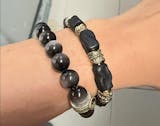The Power and Meaning of Vajra in Tantric Buddhism
The Vajra is a key symbol in Tantric Buddhism. Rooted deeply in the religious practices of Tibetan Buddhism, the Vajra holds profound meaning and spiritual significance. Exploring the Vajra's meaning and its role in the secret world of Tantric Buddhism reveals layers of spiritual depth that continue to inspire practitioners today.

What is a Vajra?
At its core, the Vajra is a ritual object that symbolizes indestructibility and irresistible force. Vajra comes from Sanskrit, commonly translated as "thunderbolt" or "diamond." Both meanings convey the qualities of the Vajra: the thunderbolt representing sudden spiritual awakening, and the diamond symbolizing something unbreakable, enduring, and pure.
Physically, the Vajra is often crafted in a symmetrical design with a central sphere and two sets of prongs extending from either side. These prongs can range from three to nine in number and are typically held by monks and practitioners during important Tantric rituals. While the Vajra itself looks small, its spiritual power is immense, symbolizing both the power to cut through illusion and ignorance and the indestructible nature of truth.

The Meaning of the Vajra in Tantric Buddhism
In Tibetan Buddhism, the Vajra is one of the most important ritual objects in Tantric practices. Often referred to as the "Diamond Thunderbolt," the Vajra symbolizes indestructibility, power, and the transcendence of duality. Its shape can vary, featuring one, three, five, seven, or nine prongs, and it is crafted from materials such as gold, silver, copper, iron, or fragrant wood. The Vajra typically has sharp blades or halo-like ends, and in its ritual use, it serves as both a representation of Buddha nature and the embodiment of masculine energy in the universe.
In Tantric Buddhism, the Vajra is often paired with the Vajra bell, a crucial tool that represents the feminine principle. The handle of the bell is shaped like half of a Vajra, and together with the bell, they form a harmonious symbolic whole. While the Vajra signifies compassion, wisdom, and strength (masculine energy), the bell embodies softness, sound, and benevolence (feminine energy). The combination of these two objects in ritual practice emphasizes the balance between masculine and feminine forces, highlighting the core tantric philosophy of unity between dualities.

The Secret of the Vajra World: Tantric Buddhism of Tibet
In the Vajrayana tradition, which is a prominent branch of Tibetan Buddhism, the Vajra holds a special place. Vajrayana literally means "the path of the Vajra," symbolizing the swift and powerful means of attaining enlightenment through the practices of Tantra. Vajrayana is often referred to as the "diamond vehicle" because it offers a fast and potent path to spiritual awakening, much like the Vajra’s powerful strike.
The Secret of the Vajra World delves into the mysteries and teachings of Tantric Buddhism. It is through this secret knowledge — known only to initiated practitioners — that individuals can use esoteric methods such as mantras, mudras, and visualization practices to tap into the divine nature of reality. The Vajra is central to these teachings, representing the practitioner’s ability to remain steadfast and clear-minded while undergoing deep internal transformations.
For many, the secret of the Vajra world lies in its symbolic message: that we all possess the potential for enlightenment within us. Through Tantric practices, practitioners work to awaken this potential and break free from the cycle of suffering. The Vajra acts as a guiding force, embodying the qualities needed to attain spiritual clarity, protection, and wisdom.

Vajra in Practice: Rituals and Meditation
The Vajra is used extensively in rituals, often alongside a bell. Together, they represent the male and female principles — wisdom and compassion — that must come together to achieve enlightenment.
During rituals, the Vajra is held in the right hand while the bell is held in the left, symbolizing the harmony of these two forces.
In meditative practices, the Vajra can also be visualized as a powerful weapon of the mind, shattering delusions and bringing forth clear, unshakable insight. Its symmetrical design serves as a reminder of balance and union, reflecting the Tantric belief in the integration of opposites on the path to enlightenment.
Vajra in Practice: Rituals and Meditation
The Vajra is used extensively in rituals, often alongside a bell. Together, they represent the male and female principles — wisdom and compassion — that must come together to achieve enlightenment. During rituals, the Vajra is held in the right hand while the bell is held in the left, symbolizing the harmony of these two forces.
In meditative practices, the Vajra can also be visualized as a powerful weapon of the mind, shattering delusions and bringing forth clear, unshakable insight. Its symmetrical design serves as a reminder of balance and union, reflecting the Tantric belief in the integration of opposites on the path to enlightenment.
Conclusion
In Tantric Buddhism, the Vajra is far more than a physical object used in rituals; it is a powerful symbol of spiritual truth, mental clarity, and the union of wisdom and compassion. Whether viewed as a tool to break through ignorance or a representation of the indestructible nature of enlightenment, the Vajra plays a crucial role in the spiritual journey of Tibetan Buddhist practitioners.
As we explore the secret of the Vajra world in Tantric Buddhism, we uncover a path that promises both power and wisdom. Through its teachings, the Vajra serves as a constant reminder that enlightenment is within reach — strong, pure, and unbreakable, much like the Vajra itself.
Related Articles:
Exploring Tibetan Meditation Bells: A Guide to Using Tibetan Bells in Tibet
What Is the Core Idea of Buddhism?

























































